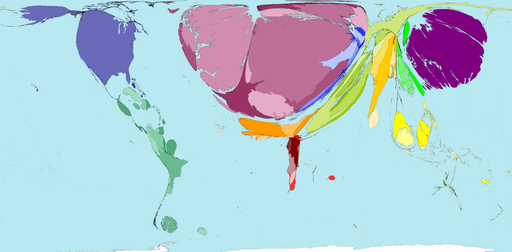Following my earlier post about cartograms, here’s one for the germplasm collections catalogued in SINGER, by country of origin. Thanks to Dr Robert Hijmans of IRRI for the birthday present.

Agricultural Biodiversity Weblog
Agrobiodiversity is crops, livestock, foodways, microbes, pollinators, wild relatives …
Following my earlier post about cartograms, here’s one for the germplasm collections catalogued in SINGER, by country of origin. Thanks to Dr Robert Hijmans of IRRI for the birthday present.

Cartograms are maps where the sizes of territories (countries, say) are proportional not to the surface area of their real-world counterparts, but rather to the value of some other attribute, like population or GDP or incidence of malaria. You can see lots of really wonderful examples on the Worldmapper website. That includes a few agricultural variables and some forestry stuff. Here’s an example of the former, net imports of vegetables by $ value.

As I said earlier in connection with Gapminder, wouldn’t it be great to be able to produce cartograms from FAOSTAT data? Or what about from the data in SINGER? Well actually that shouldn’t be all that difficult, the code for making your own cartograms is available, according to Worldmapper’s FAQ. Any volunteers?
Cartogram © Copyright 2006 SASI Group (University of Sheffield) and Mark Newman (University of Michigan), reproduced by permission. Worldmapper is at: www.worldmapper.org
You may remember a post some time back on an atlas of agriculture in Bhutan. Now here’s an on-line database of governorate-level agricultural statistics for Syria. Maybe not as nice as an atlas, but still pretty useful for planning agricultural biodiversity conservation. Especially as there is time-series data going back to 1985, which could be used to identify areas of genetic erosion through the (admittedly imperfect) proxy of decreasing total acreage. But when will agricultural statisticians and census-takers start collecting data on numbers of varieties, at least of staple crops?
Brazil has new procedures in place (called Sisbio) to issue licences to collect biodiversity for teaching and research, according to an article on SciDevNet. They are supposed to make the whole access system much easier to navigate. And faster: what used to take up to two years should now take 45 days at most. This bit struck me in particular:
Scientists will eventually be able to use Sisbio to access satellite images of potential research areas and gauge research activity in areas so they can better plan their research.
Over at CABI’s blog there’s a great post summarizing some recent research on the possible effects of climate change on the wine industry. The grapevine is very sensitive to temperature and rainfall, making it a useful indicator of environmental change. Predictably, there will be both winners and losers among the traditional wine growing areas. Not quite sure how the average consumer will come out of it, but wine bores will have a whole new area of expertise to get to grips with.